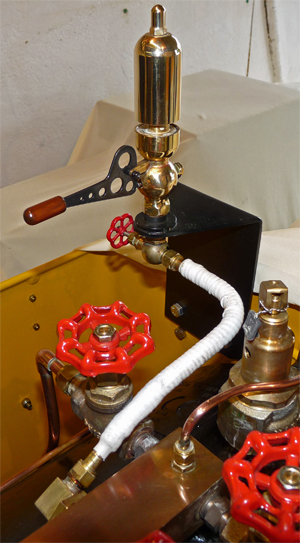 |
 |
 |
Adding a Whistle
| Quite why Station Road Steam didn't offer a whistle as an option on the first fifteen Stafford's they produced is a puzzle that only they could answer, but as a whistle is mandatory on my "home" track at the Pinewood Leisure Centre I had to fit one before I could contemplate running. From previous experience with my last traction engine I knew that R A Barker (see the links page) produced and sold some very good whistles, so after a few measurements of the Stafford I purchased a 4 inch single note whistle complete with its operating valve. The problem then was where to mount it on the Stafford so that it did not interfere with any other controls, and how to connect it into the steam fountain. | |
 The
chosen solution was to mount the whistle on a bracket bolted to the
left hand front of the cab with a steam shut-off valve underneath the
bracket and the steam feed taken via a 'T' piece from the steam pipe
leading to the boiler pressure gauge. The photo on the left
shows
the bracket and whistle, but the steam pipe shown belongs to a later
installation detailed further down this page. The copper
steam pipe
to the boiler pressure gauge can be seen rising from the steam fountain
near the bottom of the photo and the 'T' piece was originally just out
of shot to the right so that the pipe from the whistle ran
straight across the locomotive. The
chosen solution was to mount the whistle on a bracket bolted to the
left hand front of the cab with a steam shut-off valve underneath the
bracket and the steam feed taken via a 'T' piece from the steam pipe
leading to the boiler pressure gauge. The photo on the left
shows
the bracket and whistle, but the steam pipe shown belongs to a later
installation detailed further down this page. The copper
steam pipe
to the boiler pressure gauge can be seen rising from the steam fountain
near the bottom of the photo and the 'T' piece was originally just out
of shot to the right so that the pipe from the whistle ran
straight across the locomotive.The installation was quite straight forward although as supplied the whistle had a very short lever designed to be operated by a chain, so the lever shown had to manufactured. The upwards bulge of the lever by the whistle is important as it stops the whistle lever moving upwards (by hitting the whistle body) and thus prevents the whistle steam valve push rod from falling out. This installation unfortunately had two problems. First, every time the whistle was sounded the pressure gauge would drop to around 1/2 of its proper indication. Second, steam was condensing in the piping so that the whistle always started with a splutter which sounded pretty awful. Attempt two was much more like the photo on the left shows, with a new pipe being obtained to revert the pressure gauge back using its own pipe. The whistle was now connected with its own steam pipe via the adaptor that can be seen on the side of the steam fountain. This solved the pressure gauge problem but not the spluttering. So a new steam pipe was made using copper tube of larger bore and with much thicker walls, and sloped downwards all the way from the whistle to the adaptor. The hope was that the mass of copper would conduct heat from the steam fountain to help prevent condensation, while the slope would drain any condensation that did form back to the boiler. Needless to say that the whistle still spluttered. So the solution shown in the photo was tried, where the heavy duty copper piping was wrapped in two layers of thick garden string and then covered with a layer of heatshrink tubing. The end result as I'd hoped looked like a lagged steam pipe, but although the spluttering was better it still occurred if the whistle wasn't used about once a minute.  By this time several months had gone by and the whistle still didn't work properly, so I decided that it had to be relocated directly onto the steam fountain, as shown in the photo on the right. The mounting bracket and shut-off valve went into the Stafford's "spares box" along with the various pipes from the previous installations and the pressure gauge was fed by a new pipe connected to the adaptor on the side of the steam fountain that I had made previously for the whistle. The whistle could now be mounted using the tapped hole that had formerly held the pressure gauge pipe adaptor. If you look closely at the photo you may notice that the whistle adaptor is surprisingly large considering that the steam fountain was tapped 1/4x32 ME. This was deliberate to give the whistle the most rigid and supported base possible so that it wouldn't break off if accidently given a heavy knock (you don't really want an open hole into a pressurised boiler). Soft copper washers between the whistle and the adaptor allowed the whistle to be screwed on but still align along the loco's axis. At last I had a whistle that worked perfectly, and despite my initial worries the whistle lever does not seem to get in the way when you operate any other controls. So, as is so often the case, the simplest solution turned out to be the best. |
|